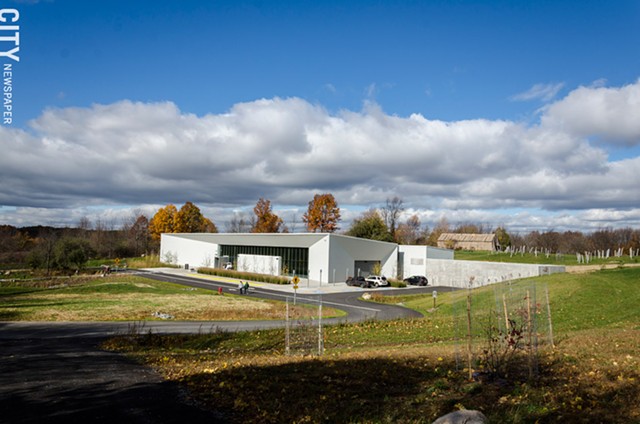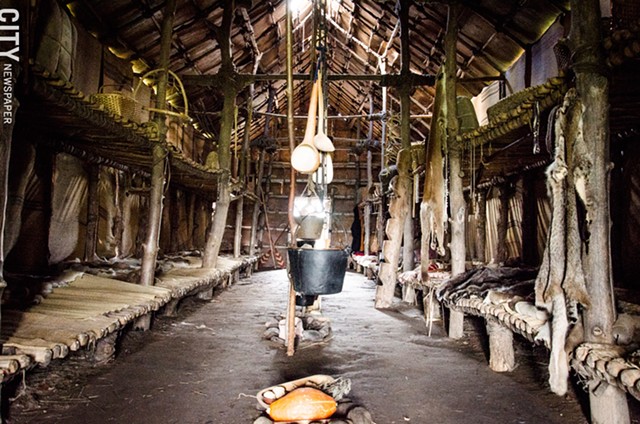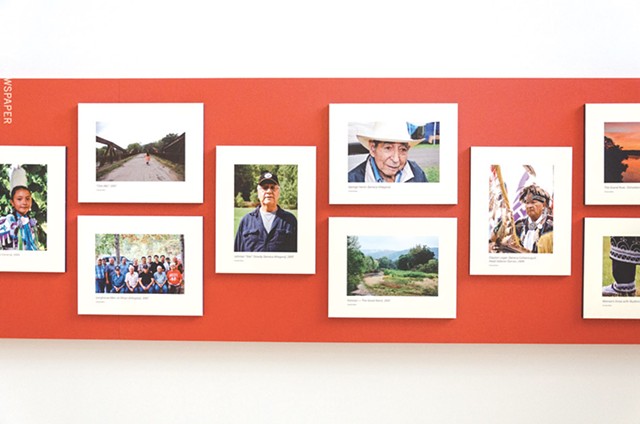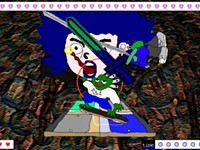
[
{
"name": "500x250 Ad",
"insertPoint": "5",
"component": "15667920",
"parentWrapperClass": "",
"requiredCountToDisplay": "1"
}
]
At the Seneca Art & Culture Center, people tell their own stories
A dream 30 years in the making has finally been realized with the opening of the Seneca Art & Culture Center at Ganondagan State Historic Site. The center officially opened on October 24, and will provide a year-round venue for exhibits and programming about Seneca history and contemporary culture. And crucially, the enduring story of the Seneca's lives and values will be told by the subjects themselves.
This is really the first time that history and culture are being shared on this scale "where the Seneca people are able to tell their own story," say Site Manager G. Peter Jemison.
"Everybody is really of one mind in really wanting to bring about a place that can show not only the historical aspect of the Seneca people but that the Seneca people are a living, breathing culture," says Meg Joseph, who heads up Ganondagan's not-for-profit partner group, Friends of Ganondagan. "So contemporary Seneca issues are at the forefront of what people are going to see when they come to the Seneca Art & Culture Center."
The new center is sleek and contemporary, but mirrors the site's raw longhouse, which is just up the hill, in its long, narrow form. The new building holds offices, classrooms, archives, a gallery, a state-of-the-art auditorium with a spring-board dance floor, dressing rooms, a catering kitchen, and a gift shop. The center will allow for year-round programming; in the past, Ganondagan has only been able to offer programming May through October, because the longhouse and trails were a strictly outdoor site.
The building will serve as a resource center where visitors from near and far can more fully engage with the history of the Seneca, which is the history of this region. Through exhibits on historic and contemporary culture, lectures, classes, and performances, the stories told within will serve to spark our understanding of what was, and increase our awareness of what Seneca culture is today.
Tangible history
Fifteen artifact-rich, interactive exhibits fill the SACC's gallery, "each of them telling an important story we feel people should know about Ganondagan," says Michael Galban, Ganondagan historian and interpretive programs assistant.
Galban curated the ethnographic and archaeological exhibits at the SACC, and will be managing Ganondagan's collections in the archival space. The building will both store and share Seneca knowledge, available for Seneca and non-Seneca researchers to study.
"We're certainly not your typical museum," Galban says. "We have a cultural center, which has a museum component, but our philosophy is that we have a continuity of representation."
The center will share archaeological finds that explore the Seneca of 300 years ago, the ethnography of more recent times, and also contemporary Seneca stories. "Without that continuity, people aren't really getting the entire story," he says.
Through objects, dioramas, artwork, and video segments, visitors learn about life at Ganondagan while it was inhabited by the Seneca, and about interactions with Europeans from the perspective of the natives. Spoons and combs carved with human figures show how the Seneca perceived themselves, while illustrations reveal how the Europeans saw the Seneca.
Historically, the Seneca were the largest and westernmost group out of six nations of Native Americans that made up the Iroquois Confederacy (also called the Haudenosaunee), a democratic government that pre-dates the United States Constitution.
The village and cornfields at the Seneca village of Ganondagan were razed in 1687 by French colonists determined to take over the lucrative fur trade, and the Seneca were forced to flee. On display in the exhibition space is the actual document that King Louis XIV sent from Versailles to give Marquis de Denonville powers over the colony's military, lands, and economy. "It also directed him to subjugate the Iroquois," Galban says. Knowing the destruction that followed lends an undeniable gravity to the fragile parchment.
An extremely detailed model of a longhouse at one-fifth scale is filled with items of material culture to help audiences envision the compact efficiency of daily life. A model of the region from above shows what the longhouse village, cornfields, trails, and hunting grounds might have looked like. Maps tell the story of Iroquois expanding and defending their territory in relation to other nations of people living in the wider region. A case focusing on trade holds examples of the kinds of items, including beaver skins, blankets, and beadwork, that were exchanged.
"Some of the artifacts that were collected over the past 100 years or so at Seneca sites were in fact once part of funerary context," Galban says. SACC organizers made a commitment early on in their exhibit development that they would not display objects that came from a funerary context.
"That's very limiting," Galban says, "because objects carefully placed in those interments tended to last much better than objects discarded on the top of the ground."
Galban had to explore other ways of presenting these objects, and enlisted Denis Cormier of RIT's College of Engineering for help with 3D scanning and printing. For example, some moose antler combs were reproduced and given a believable patina. "They have the appearance of the originals," Galban says. "So we have a visual record without infringing on the sensitive nature of objects that came from a grave."
As an historical resource center, the SACC will offer the Seneca a sense of pride and comfort, Galban says.
"On one level, Seneca people themselves are our most important audience. We have a responsibility as caretakers of culture to the Seneca people. But through the center, Ganondagan will be even more of an asset to the community, and an even better bridge between the Seneca people and the rest of the world."
Living, breathing legacy
One of the first impressions visitors will have upon entering the center is from a multi-sensory, engaging exhibit focused on the Thanksgiving Address, which initiates all Haudenosaunee meetings, gatherings, and in some communities, is recited every morning.
"It acknowledges all aspects of what we consider Creation," Galban says. "So the visitor is immediately struck with this exhibit that has objects which reflect the different elements of creation, an actual Seneca language recitation with English subtitle, and a video piece that was produced by a Seneca filmmaker."
Just a bit before the center's opening, the space hosted an international symposium of material culture experts. Galban is working on organizing a future exhibit that would present "an exceptional collection of 18th century woodland objects" collected by a prominent eastern European leader, he says.
Right now, the center is host to a photo and story exhibit by Seneca artist Brenda Mitten, which showcases contemporary leaders and elders in Seneca communities.
The center's programming will have an emphasis on dancers, musicians, and artists who are doing contemporary work. "There is so much to offer that's happening right now, and Ganondagan is really at the forefront of providing an arena and venue for very talented contemporary artists," Peter Jemison says.
Native American artwork is the original artwork of this country, he points out. "It is the original art of this state, of this region. Here is what evolved over time. And what's still going on. Here's an opportunity to see, to discuss, the state of Native American art and artists of today."
Jemison is an accomplished artist himself. Before moving to the region to manage Ganondagan in the 1980's, Jemison ran a gallery in New York City that showed contemporary Native American art. And since moving here, he's curated about 10 biennials with the same focus. But Native American art has never seen widespread appreciation.
"I don't really feel that Native American art in general has been given really serious consideration," Jemison says. "I think many people just don't get it."
With the opening of the SACC, there is finally a permanent space dedicated to showing and exploring Seneca art.
Safeguarding sovereignty
The Seneca Nation is one of more than 500 Native American nations that navigates a complex existence within the United States. The larger Seneca community includes four reservations and more than 8,000 citizens. The Seneca's sovereignty is not something that many Americans consider on a day-to-day basis, unless there is some international contention that makes the news. Interestingly, this aspect is told at the SACC through sports.
In the gallery space, a massive display case lining one wall is reserved for rotating exhibits. The first of these spotlights the Iroquois National Lacrosse Team, explored through an exhibit of photographs, newspaper articles, helmets, jerseys, and lacrosse sticks.
The INLT competes internationally in indoor and outdoor lacrosse, and draws players from all of the Haudenosaunee nations.
"Because they compete internationally, they have pushed the idea of Haudenosaunee sovereignty into the forefront," Galban says. "They travel on their own passports; they have their own national flag and national anthem."
As described in some of the newspaper clippings, the challenges of having a recognized, respected sovereignty was spotlighted in 2010, when the INLT were expected to spend a week competing for the world championship. Instead, they were blocked by the British government, which refused to recognize their tribal passports, and forced to forfeit the first game against England, and ultimately prevented their participation in the championship altogether.
Acceptance of the Iroquois passport varies country by country, Galban says. "That country needs to be assured that your passport is legitimate, that's one level," Galban says. "It also needs to be reassured that you can gain reentry to the country you came from."
The exhibit, on the outside, is about this Lacrosse team, Galban says. "But the subtext is about sovereignty, self-determination, independence, the right to self-govern from a Native perspective."
Borrowed ideas: democracy and suffrage
Much of the foundation of the United States government was shaped by important political concepts learned from the Haundenosaunee. For example, the US Constitution is partially based on democratic ideals learned from the Iroquois Confederacy, and the Seneca's matriarchal society was part of the inspiration for the 1848 Declaration of Sentiments, which led to the Suffrage movement.
"People could see it was a matrilineal society," Meg Joseph says. "And women had a very important responsibility. They walked side-by-side with men, and that was something that was very influential" on American women.
"One of the things we talk about here is the role of our women and our clan mothers," says Ganondagan site interpreter Ronnie Reitter. Dating back to the time of the Peacemaker who united the original five nations, the Mother of Nations (the historic figure Jikonsahseh) "gave our women the right to elect our chiefs," she says. "It's our women who listen to the people, and take that message to the chiefs in council."
Historians estimate the events Reitter speaks of took place between 1450 and 1600. Remember, it hasn't even been 100 years since American women won the right to vote.
"It's not only about putting that right person into that leadership role," Reitter says, "but also keeping our eye on him and making sure that he does his job, that he does it to the best of his ability, that he doesn't overstep it for his own personal gain. So it's a huge responsibility."
There is a three-warning system for transgressions in the leadership, resulting in what's called "de-horning the chief," which refers to the deer antlers worn on traditional headdress, Reitter says.
"It was a serious thing. It wasn't just him, it was his family, his clan" who bore the disgrace, she says. "The chief would end up leaving the village, because he would cease to exist in their eyes."
Ultimately, Seneca values are about balance. "It's the balance between males and females that keep things on an even keel," she says. "It's the balance with people and nature. It all ties in."
Lessons in sustainability
"Friends of Ganondagan acts as a bridge between Native and non-Native Americans," Meg Joseph says. "Our programming is inclusive, and we look for ways to create friendships and to share culture, and to educate people."
An important part of what FOG does "is to offer values that are alternative to popular culture," she says. "And that's really something that is embraced not only with the youth, but also with really like-minded folks whose values are in line with social justice, with sustainability, with food sovereignty, with democracy, and underlining a message of peace."
You may have heard of the concept of "seven generations." The idea is to promote consciousness through considering that every action we make can affect the next seven generations to come. The 17,000-square-foot SACC was constructed with green building elements, including geothermal heating and cooling, and windows and skylights to take advantage of natural light.
The FOG helps steward the Iroquois White Corn Project, which keeps the Seneca's sacred heirloom seed alive. The seed is descended from the original plants grown in the region, and keeping it places an emphasis on organic, local, non-GMO produce.
The greater community can attend the Husking Bees held every October, which are "wonderful community events, like no other," Joseph says.
The bees really allow participants to learn about the culture and the people who have traditionally husked and braided corn, to hear stories and get to know people, and taste White Corn dishes.
The corn is planted at Ganondagan, prepared by FOG and volunteers, and available through Ganondagan and some Wegmans stores. "We want people to get back into the habit of using our traditional foods, and make it available to anyone else who is interested in eating it," Reiter says.
Being involved with the Friends of Ganondagan has been "an extremely humbling experience," Joseph says. Though she is not Seneca, she says she's been welcomed into the community. "I've not only learned a lot about the culture and what it means to be Seneca, but I've also learned a lot about how I can be a better person by trying to follow the values that have been shared with me."
Speaking of...
-
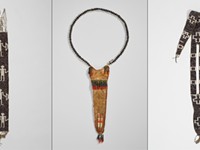
Wampum exhibit at Ganondagan is a homecoming for history
May 6, 2023 -
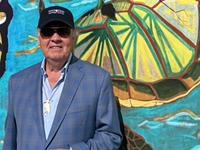
Seneca artist G. Peter Jemison awarded national arts fellowship
Feb 13, 2023 -

Frida Kahlo: the making of an art icon
Nov 11, 2022 - More »
Latest in Culture
More by Rebecca Rafferty
-

Beyond folklore
Apr 4, 2024 -

Partnership perks: Public Provisions @ Flour City Bread
Feb 24, 2024 -

Raison d’Art
Feb 19, 2024 - More »
